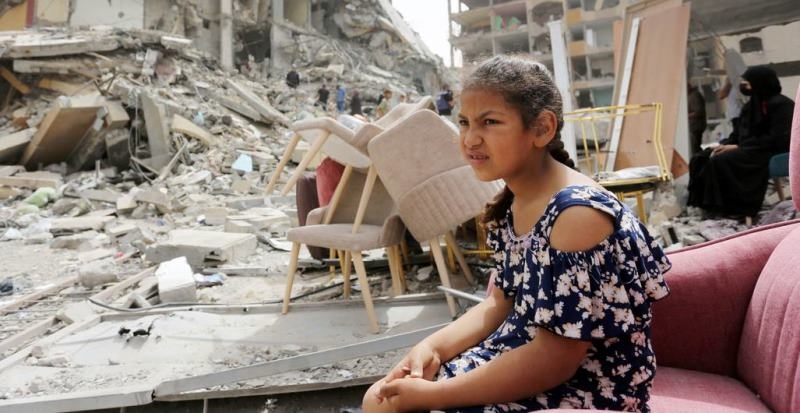- CA Yunus pays homage to Liberation War martyrs on Victory Day |
- Bangladesh capital market extends losing streak for second day |
- Bangladesh celebrates Victory Day Tuesday |
- 'Different govts presented history based on their own ideologies': JU VC |
Gaza is more than two million stories of loss: UN agencies

A girl sits among the rubble of destroyed buildings in Gaza. © UNRWA
21 June 2024 - Gaza is “a world of devastation” and still in the grip of war after nearly nine months of conflict, UN humanitarians just back from the enclave reported on Friday, as they described widespread destruction and stories of pregnant mothers forced to request preterm C-sections out of desperation and fear.
“The population has been almost entirely dispossessed of the means and capacities to ensure food security, shelter, health, and livelihood,” said Maryse Guimond, UN Women’s Special Representative for the Occupied Palestinian Territory. “Women were asking me, ‘When can we go back to our homes?’ Each displacement has brought more loss and fear.”
Dignity, privacy gone
Speaking to journalists in Geneva via video, veteran humanitarian worker Ms. Guimond described seeing people “crammed” into makeshift shelters and lacking even the most basic essentials. At one school-turned-shelter run by the UN agency for Palestinian refugees (UNRWA), there are only 25 toilets for the 14,000 people seeking safety inside the compound and the 59,000 others camping outside, she noted.
Pointing to the “enormous” problems of access to Gaza’s last functioning hospitals today, Dr Rik Peeperkorn from the UN World Health Organization (WHO) reported that the enclave’s health workers, obstetricians and doctors now treat far higher levels of low birthweight babies than before the war.
C-section desperation
“We see a lot of preterm babies and low birthweight babies and you see that often in times of conflicts, war…but we even had the stories where women were going when they had access to the hospital would ask for an early Caesarean to make sure that they deliver and deliver safely because they were completely unclear and they were scared about the access, if they would be able to access the hospital later, because of the volatile security situation and the constantly changing situation.”
Beyond the risks of giving birth in Gaza today for mothers and their babies in a place where “there is hardly any antenatal care”, the WHO medic highlighted the “amazing” amount of trauma cases, amputees and patients with chronic health conditions who urgently need to be evacuated out of the enclave for treatment.
Medivac appeal
Since war erupted on 7 October after Hamas-led terror attacks in Israel, roughly 4,800 patients have been evacuated out of medical necessity from Gaza, most to Egypt and elsewhere in the region.
But “at least another 10,000 patients” now need specialist treatment outside the enclave, Dr Peeperkorn said – “half of them related to the war and half of them related to what we call the chronic diseases: ...cancer, cardiovascular diseases and other non-communicable diseases, including severe mental health cases”.
Some 50 to 100 medical evacuations used to happen regularly from Gaza to hospitals in the West Bank before the war, the WHO official explained, as he appealed for the reopening of Rafah border crossing in the south of the enclave, or for nearby Kerem Shalom to be used instead.
The UN health agency also pushed back at Israeli Defense Force (IDF) claims that recently announced pauses in fighting have led to an improvement in the humanitarian situation.
“And the reason is that this humanitarian pause was not reflected on the ground; there was not a single day where we could be able to say we are going to take advantage of this humanitarian pause…to bring from Kerem Shalom the supplies that are waiting for us,” said Dr Thanos Gargavanis, WHO trauma surgeon and emergency officer.
The UN aid coordination office, OCHA, echoed those concerns and insisted on Israel’s responsibility under international humanitarian law as the occupying power to ensure that relief supplies including fuel reach those who most need it, including by addressing the “complete destruction of law and order” and reports of looting.
“Of course, we welcome any initiative that aims at facilitated aid delivery and we did reach an understanding with COGAT on coordinated movements intended to facilitate safe movements of humanitarian aid,” said spokesperson Jens Laerke, referring to the Israeli body overseeing deliveries.
“In reality, as we hear from the ground, it has come to very little. Fighting in the area might have reduced as a result of those coordinated movements but it is not the only impediment for our colleagues to pick up aid in the area between Kerem Shalom and the Salah Al Din road.”
Fractional benefits
Echoing those concerns, WHO’s Dr Gargavanis said that the impact of the closure of the Rafah crossing, the increase in fighting and the continued forcible displacement of Gazans meant that what is achieved in Gaza “is only a fraction of what we should be doing”.
He added: “I know that we are saying this repeatedly over and over again. However, everybody needs to understand that for every international (worker) that is now entering in the Gaza Strip, the process is long, risky, and it requires a huge amount of resources”.
“Right now, through Kerem Shalom, we have to lead ourselves, we have to drive the armoured vehicles ourselves to make sure that international community continues to go in and rotate out of the Gaza Strip. This is just one of the major issues that we're facing.” – UN News

